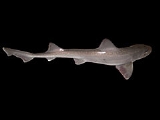
Common smooth-hound
Encyclopedia
The common smooth-hound, Mustelus mustelus, is a houndshark of the family
Triakidae, found in the eastern Atlantic Ocean
from the British Isles
to South Africa
, in the Mediterranean Sea
, Madeira
and the Canary Islands
at depths of ranging from 5m to 625m (although they usually stay at depths of 5-50m). While they can grow to 200 cm, their usual maximum size is 150 cm. They commonly grow to 100–120 cm with a birth length around 35 cm.
Reproduction is viviparous.
which has white spots on its back. The starry smooth-hound
can often have faded spots which leads to misidentification. Another shark it is often confused with is the tope shark although the common smooth hound has a larger second dorsal fin. Due to the similarities between the common smooth-hound and other sharks, misidentification occurred for a long time.
The common smooth-hound has two dorsal fins, an anal fin, a pair of pectoral fins, a pair of pelvic fins and a heterocercal tail. All of these fins help stabilise the shark but in males, the pelvic fins are modified to form claspers.
Like other smooth hounds, the common smooth hound will aggregate in large numbers, like a pack of dogs. This is why they are called hounds.
Family (biology)
In biological classification, family is* a taxonomic rank. Other well-known ranks are life, domain, kingdom, phylum, class, order, genus, and species, with family fitting between order and genus. As for the other well-known ranks, there is the option of an immediately lower rank, indicated by the...
Triakidae, found in the eastern Atlantic Ocean
Atlantic Ocean
The Atlantic Ocean is the second-largest of the world's oceanic divisions. With a total area of about , it covers approximately 20% of the Earth's surface and about 26% of its water surface area...
from the British Isles
British Isles
The British Isles are a group of islands off the northwest coast of continental Europe that include the islands of Great Britain and Ireland and over six thousand smaller isles. There are two sovereign states located on the islands: the United Kingdom of Great Britain and Northern Ireland and...
to South Africa
South Africa
The Republic of South Africa is a country in southern Africa. Located at the southern tip of Africa, it is divided into nine provinces, with of coastline on the Atlantic and Indian oceans...
, in the Mediterranean Sea
Mediterranean Sea
The Mediterranean Sea is a sea connected to the Atlantic Ocean surrounded by the Mediterranean region and almost completely enclosed by land: on the north by Anatolia and Europe, on the south by North Africa, and on the east by the Levant...
, Madeira
Madeira
Madeira is a Portuguese archipelago that lies between and , just under 400 km north of Tenerife, Canary Islands, in the north Atlantic Ocean and an outermost region of the European Union...
and the Canary Islands
Canary Islands
The Canary Islands , also known as the Canaries , is a Spanish archipelago located just off the northwest coast of mainland Africa, 100 km west of the border between Morocco and the Western Sahara. The Canaries are a Spanish autonomous community and an outermost region of the European Union...
at depths of ranging from 5m to 625m (although they usually stay at depths of 5-50m). While they can grow to 200 cm, their usual maximum size is 150 cm. They commonly grow to 100–120 cm with a birth length around 35 cm.
Reproduction is viviparous.
Morphology and behaviour
The common smooth-hound has a grey-brown back and is white on its underneath. It is often confused with the starry smooth-houndStarry smooth-hound
The starry smooth-hound, Mustelus asterias, is a houndshark of the family Triakidae, found on the continental shelves of the northeast Atlantic between latitudes 61° N and 16° N, from the surface to 350 m. Its length is up to 1.4 m.-References:...
which has white spots on its back. The starry smooth-hound
Starry smooth-hound
The starry smooth-hound, Mustelus asterias, is a houndshark of the family Triakidae, found on the continental shelves of the northeast Atlantic between latitudes 61° N and 16° N, from the surface to 350 m. Its length is up to 1.4 m.-References:...
can often have faded spots which leads to misidentification. Another shark it is often confused with is the tope shark although the common smooth hound has a larger second dorsal fin. Due to the similarities between the common smooth-hound and other sharks, misidentification occurred for a long time.
The common smooth-hound has two dorsal fins, an anal fin, a pair of pectoral fins, a pair of pelvic fins and a heterocercal tail. All of these fins help stabilise the shark but in males, the pelvic fins are modified to form claspers.
Like other smooth hounds, the common smooth hound will aggregate in large numbers, like a pack of dogs. This is why they are called hounds.

